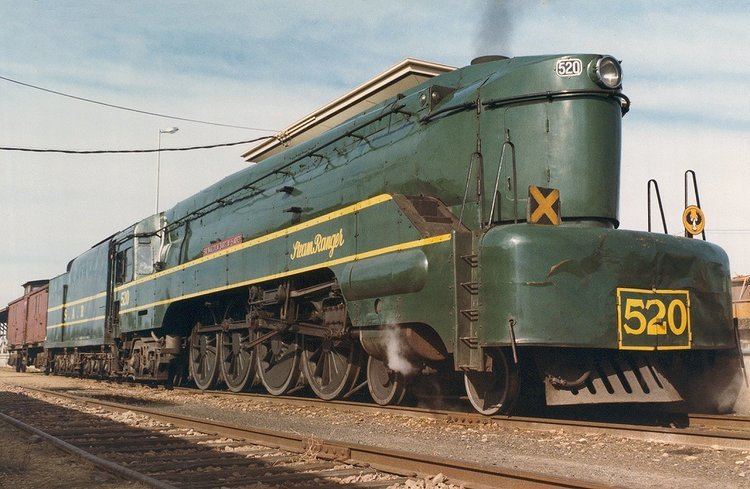Power type Steam Serial number 81-92 Total produced 12 | Designer Frank Hugh Harrison Build date 1943-1947 | |
 | ||
Builder | ||
The South Australian Railways 520 class was a class of 4-8-4 steam locomotives operated by the South Australian Railways.
Contents
History
During the war years in the early 1940s, the South Australian Railways (SAR) had a desperate need for additional tractive power on increasingly growing troop and supply trains and with the combined need for quick acceleration and high speed running on the flat and general straight mainlines to the north to Port Pirie, as well as power "under the belt" for the long 19-mile (31 km), 1-in-45 (2.2%) graded slog up the Adelaide Hills to Melbourne, a new locomotive design was required by the SAR. With this in mind, the 520 class was commissioned, combining the better features of the earlier 500 and 620 class locomotives.
The class used the 4-8-4 configuration of the modified 500B class, but was also designed for work on branch lines with light 60-lb/yard (29.7 kg/m) rail with a reduced tender load. The considerable weight of the locomotive was spread over eight axles, four driving and four in the leading and trailing trucks, yielding the necessary light axle loading for operation over the aforementioned territory. The 520s used this to the fullest, their normal mainline stamping grounds being on fast crack express services on the Pirie line, namely the East-West Express, but also serving upon many of the Tailem Bend mixed and radiating branchline trains. The only lines that they were restricted from running on were those laid with very light 40 lb or 50 lb rail.
The class featured extravagant streamlining, in the style of the Pennsylvania Railroad's T1 in the United States. The original streamlining was more closely based on the T1, and class members 520-522 were fitted with such. Members 523-531 were built with a narrower front profile, attributed to by the "crown" of grill around the chimney front. The earlier streamlined model had a lower front, resulting in a squat chimney profile extended from an otherwise graceful, albeit useless, streamlined casing. During their service life, some of the class lost the cowling around their front buffer beam, a move which simplified maintenance.
The 520 class locomotives were noted for their impressive displays of power and speed. They featured specially balanced driving wheels that while only 66 inches (1,676 mm) in diameter, were designed for 70-mile-per-hour (113 km/h) operation, and were also the first locomotives in Australia to feature Timken roller bearings on all axles. Classleader 520 attained a speed of 78 miles per hour (126 km/h) between Red Hill and Port Pirie when it entered service on 10 November 1943. Surviving test records show the locomotive was capable of developing an indicated horsepower output of 2,600 horsepower (1,940 kW) at 70 mph while hauling a 510-tonne (500-long-ton) load.
A total of 12 locomotives were built at Islington Railway Workshops between 1943 and 1947. They were progressively replaced in service from the early 1960s by diesel locomotives, and in particular the 830 class, as repairs, namely to boilers, were required. It is interesting to note that the 520s were the first class in South Australia, and possibly Australia, to facilitate the use of completely welded boiler assemblies, an idea adopted by their designer Frank Hugh Harrison after a trip to the United States of America.
The class earned themselves the name the "whispering giants". They were known as such, not for their soft exhaust - the 520s, while not as much as their larger 500B cousins, still shook the earth on their ascent into Mount Lofty Yard. Due to their long boilers the class had the characteristic feature of requiring blower assistance while in yards to prevent blowback or drifting smoke into the cab, which was nearly entirely closed. Hence, when drifting or in stations or stationary, the class were known to quietly whisper.
Preservation
Two have been preserved:
Fiction
In the 2016 Thomas & Friends movie The Great Race, a character named Shane was based on the SAR 520 Class.
